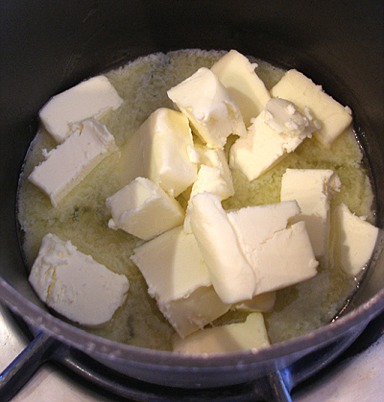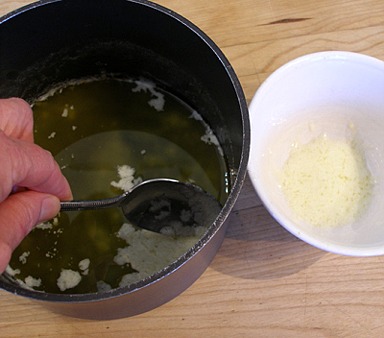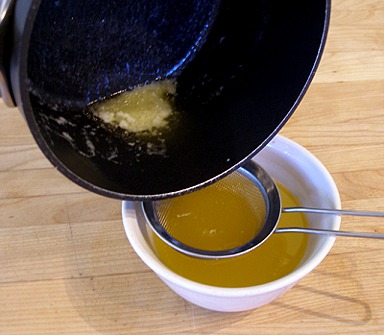Butter is made up of butterfat, milk solids and water. Clarified butter, also known as Ghee in some countries, is the translucent golden-yellow butterfat left over after the milk solids and water residue are removed during cooking. You can make your own clarified butter, or buy it. If you do not remove them, you can further brown or essentially fry the separated milk solids, and it is called Brown Butter or Browned Butter (Beurre Noisette). The texture, color, or taste of clarified butter depends on the source of the milk from which the butter was made and the extent of boiling and simmering. Although butter in the United States is almost always made from cow's milk, the ghee used for cooking in India is often made from buffalo milk, and uses a different process.
Clarified butter is useful in all kinds of butter-based emulsified sauces, such as Hollandaise and Béarnaise. The reason is that the water in ordinary butter tends to make the emulsion break. Clarified butter, with the water removed, eliminates this problem. Clarified butter and Ghee have a higher smoke point than butter, useful when cooking at high heat, although Ghee has the highest being between 400 to 500 degrees F. For butter, smoke point is typically reached between 325 to 375 degrees F, and some clarified butters also fall into this general range. Clarified butter is also useful for preparing baking pans and stores well.
This how to baking technique is used with the:
 Crepes Tutorial
Crepes Tutorial
 Traditional Walnut-Almond Baklava Recipe
Traditional Walnut-Almond Baklava Recipe
 Healthy Oven Pear Baklava Tutorial
Healthy Oven Pear Baklava Tutorial
HOW TO TIPS:
INGREDIENTS
Clarified or browned butter will be only 75% the volume or weight of whole butter:
1 cup (2 sticks or 1/2 pound) butter = 3/4 cup clarified or browned butter.
4 tablespoons butter = 3 tablespoons clarified or browned butter
INSTRUCTIONS
1. In a heavy-bottomed saucepan, melt the unsalted STICK butter over medium-low heat. The melting butter will begin to form a white foam on top. This is the butter's water content boiling off.

2. Then, turn the heat to low, so the butter simmers, stirring occasionally. The froth will begin to thin slowly and the color of butter changes to a pale yellow shade.
3. Then, continue to cook on low heat until the butter turns a golden color. The residue of milk solids will separate from the butterfat and water at the bottom of the pot. The clarified butter, which is now clear, golden and translucent with a fragrant smell, is ready.
4. Remove from heat and let stand a few minutes. Skim off the top foam and optionally, discard; it's fantastic on popcorn!

5. Slowly pour off clear yellow liquid or the clarified portion of the butter through a small strainer, into a covered jar, leaving behind the residue of milk solids from the bottom of the pan.
Discard the milk solids.

STORAGE
Clarified butter keeps for a least 3 weeks, well covered, in refrigerator or freezer. It can be stored without refrigeration, provided that it is kept in an airtight container to prevent oxidation and remains moisture-free.
BROWNED BUTTER OR BEURRE NOISETTE
Allow the separated milk solids to turn deep brown. You can stir at this point in order to disperse the flavor of the browned solids throughout the butter. Strain the butter immediately through a fine mesh strainer or cheese cloth-line strainer.


